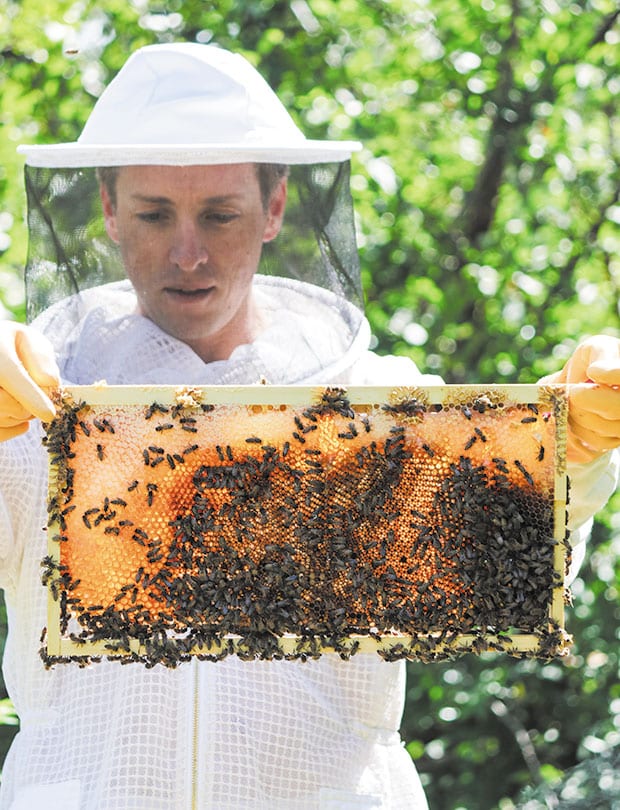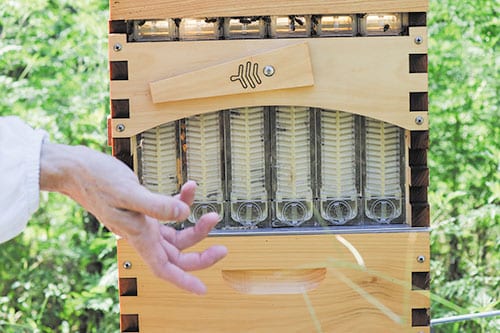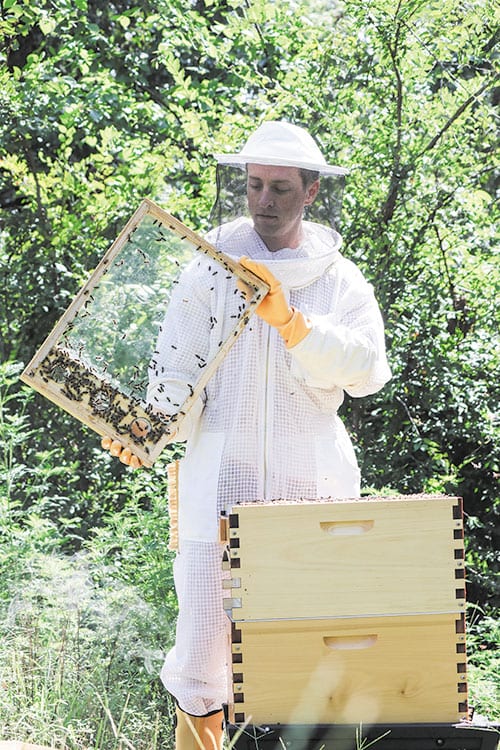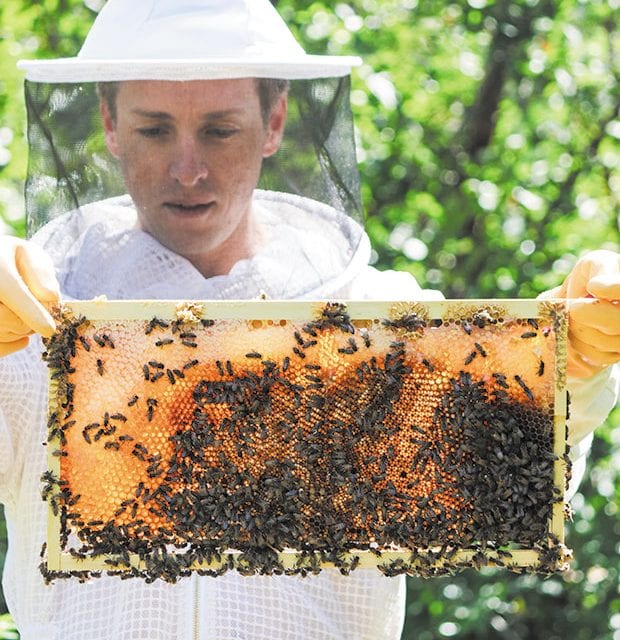Dallas businessmen — and best friends — plan a golden future with their country farm and Queen Mary Honey

Tammye Nash | Managing Editior
nash@dallasvoice.com
Think of them as the Golden Girls, except instead of four older straight women, they are four not-really-older gay men. And instead of Miami, their story is set (at least partially) in Canton, Texas.
And there are bees. Honeybees, in fact. Lots and lots of honeybees.
Now, there are a few other differences, too between TV’s Golden Girls and Canton’s honey boys. Blanche, Dorothy, Sophia and Rose started out as strangers who became roommates then best friends, while Clint, Jeff, J.T. and Derek were best friends who became roommates and home co-owners.
 And while the Miami girls were at the end of or retired from their careers, the Dallas guys are at the height of theirs — and at the same time, just beginning a new adventure with Queen Mary Honey, their fledgling food and beverage venture based at their Canton-area vacation home.
And while the Miami girls were at the end of or retired from their careers, the Dallas guys are at the height of theirs — and at the same time, just beginning a new adventure with Queen Mary Honey, their fledgling food and beverage venture based at their Canton-area vacation home.
Clint Thomson, the head bee charmer at Queen Mary, explained that he, Jeff Fielder and couple J.T. Williams and Derek Selders were best friends that spent all their time together. Before long, he said, they decided that since they already spent all their time together, they might as well live together.
“So we all moved in together a while ago, and it has worked out really well,” Clint said. It’s gone so well, in fact, that the friends decided to purchase a vacation home together.
“We started looking for property out in the country. We searched and searched until we found this property,” Clint said. The property is about 10 acres, just south of Canton on Highway 19, with two houses and a barn, heavily wooded and bordered on three sides by a large commercial nursery that focuses on growing various trees.
He continued, “We wanted a new adventure, some place where we could do natural things,” like raising livestock and gardening. And keeping bees.
Clint explained that the idea of keeping bees and harvesting and selling the honey came from him. “About 10 years ago, I lived in Goldthwaite, Texas, and I started keeping bees there. There was a man there named Ralph Ishmael who was my bee mentor. He was retiring from the business, and he gave me all his equipment.”
Back in Goldthwaite, Clint said, “I didn’t really harvest any of the honey. It was more about learning to keep the bees. They are fascinating creatures, and I really loved learning about them.
“But circumstances changed. I moved away from Goldthwaite and I gave up the beekeeping,” Clint added. “Then, flash forward 10 years, and here we are with this property, and I thought, why not do beekeeping again? And this time, actually do it commercially.”
So last year Clint ordered the hives, which arrived disassembled, and last December he put four of them together and situated them on the property. In early spring he introduced the bees — which can also be purchased via mail order, he said.
“It takes a little while to build each hive, to put it together,” Clint said of the high-tech bee homes he uses. “I have others to assemble that I will put out eventually. But they are still in boxes right now. You can only set up a hive in early spring.”
Bees are, in general, pretty self-sufficient creatures, Clint said. Once they are in their hives, “I really only have to make periodic checks. Here where we are, they have plenty of food sources around, and there is a creek that runs right through the property, so they have water, too.”
 There are certain dangers to watch out for, he said, and he looks for ways to address problems in the most natural, most effective and most efficient ways possible.
There are certain dangers to watch out for, he said, and he looks for ways to address problems in the most natural, most effective and most efficient ways possible.
“By bringing in the bees, we really are helping the whole area,” Clint said, explaining that by going about their usual day-to-day bee business, the bees are helping pollinate plants all around them, which keeps crops healthier and more productive.
“From the numbers I’ve seen, farmers can get up to a 30 percent increase in yield when there are bees to pollinate their crops. Some crops, like almonds, can’t survive without bee pollination,” he said.
That means that there is a market for beekeepers who want to lease out hives, placing them on properties where crops are being grown to help increase the crops’ yield. In fact, Clint said, he has already been approached by a man who grows flowers near Kaufman to do just that, and he hopes to be able to place some hives there by next spring.
The fact that honeybees have been dying off in large numbers has made plenty of headlines in recent years, and Clint said that is due to a “combination of factors,” with pesticide use at the top of the list.
The main problem, he said, are neonicotinoids, systemic pesticides that are put on the seeds of a plant so that as the plant grows, the pesticide is part of the plant itself, instead of a separate substance applied to the plant.
“The bees get on the plant and take the nectar or the pollen. They aren’t killed by retrieving the pollen or nectar, but they take it back to the hive, and the hive is slowly poisoned,” Clint explained. “The bees then flee en masse and die. That is called colony collapse disorder.”
There are also small parasites that can invade the hives and injure and kill the bees. One is the small hive beetle, which is really only a danger to hives that are weak to begin with. Another is the varroa mite, which bites through a bee’s carapace to suck its blood, compromising the bee’s immune system and weakening it.
While some beekeepers treat the parasites with chemicals, Clint said he chooses non-chemical methods. For example, while he hasn’t had any real problems with varroa mites so far, if he finds any, he simply heats the hive to 113 degrees — hot enough to kill the mites but not hot enough to harm the bees.
Clint said he also purchases queen bees bred to be more resistant to mites and uses other integrated pest management techniques.
He has also chosen to use high-tech hives that, while more expensive in the beginning and a bit harder to assemble, pay off in the end by allowing better honey harvests with less waste and less disruption to the bees.
“Harvesting the honey used to take forever the old way, and it was very traumatic for the bees,” he said. “With these new hives, we hardly have to disturb the bees at all.”
In “the old days,” bee hives had wooden frames lined up, side by side, inside the boxes, creating the bases on which the bees built their honeycombs. To harvest the honey, beekeepers had to remove each frame, cut the honeycomb from it then strain the honey.
In the new hives, the frames come with the “honeycomb” already built in. The bees deposit their honey, and when the time comes, the beekeeper can open a side panel — separated from the “honeycomb” and the busy bees by a clear panel, uncap the tubes that run from top-to-bottom in the comb, turn a key and watch the pure, clear honey drain into capture tubes.
“The honey is so pure and clean that I could take a piece of toast out there, wipe the honey off the [drain tube] with it and eat it right there,” Clint said.
“It comes ready to eat, straight from the hive. And all the pollen and good stuff that would have been strained out the old way is still in it. The savings in manpower alone is worth the extra cost initially.”
He said that each frame in the hive can produce a half-gallon of honey at a time, and it takes the bees two to four weeks to fill a frame. His hives have seven frames, which means every two to four weeks he can harvest about three-and-a-half gallons of honey from each of the four hives.
Next spring, he added, he plans to add six more hives.
“These hives just came out in the last couple of years, and it is making a revolutionary change in the honey industry,” he said. “It makes it possible for a much smaller operation to run a massive apiary. It cuts down on the cost of harvesting the honey, which means better profit in the short term. And in the short term, it will help bring down the price of quality, local honey.”
Some of the hives use frames that allow room for the bees to build their own wax honeycomb, and that comb can also be harvested and used for products, many of which Clint and the others intend to add to their product line.
They hope to add to their farm, too, and each one has his own specialty. J.T. is the one who looks after the elderly pig, Pork Chop, who came with the property. Derek does most of the gardening, and Clint and Jeff are the ones who look after the bees.
Right now, the four men are all very busy with their lives in the big city: Clint is a computer consultant who operates Solera
Tech, offering managed services to small businesses; Jeff and J.T. are both closers in the title industry, and Derek works in the mortgage industry.
They also stay busy as volunteers with various organizations in the LGBT community. Clint was co-chair for Lambda Legal and now serves on the North Texas GLBT Chamber of Commerce board. J.T. founded The Red Party and is currently chair of the chamber.
But, Clint said, they hope to someday be able to retire from city life and focus on operating Queen Mary Honey and living the life of gentleman farmers on their property.
“We want to get some goats, and maybe make products that use goat cheese and honey,” Clint said. “We want to use the wax from the honeycomb to make lip balms and hair waxes and things like that. Maybe when someone is living here all the time, we’ll get some chickens. And we’ll sell honey.
“Someday, I’m gonna be able to just sit in my rocking chair and sell honey to the people who come by. That’s the plan.”
This article appeared in the Dallas Voice print edition August 4 2017.


